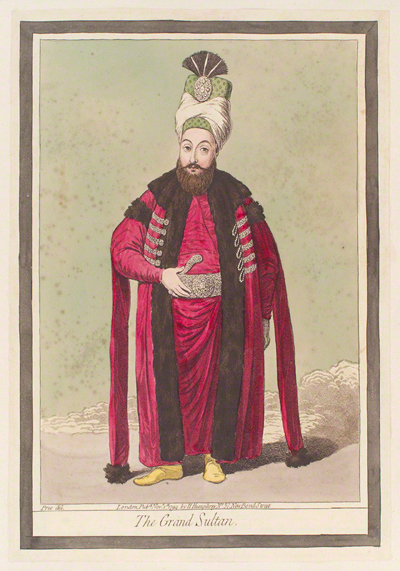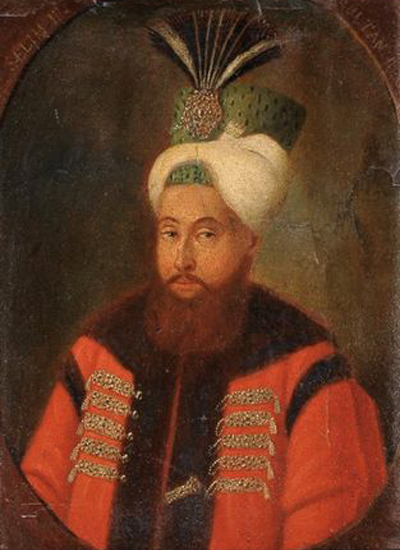The Grand Sultan
With the arrival of the Turkish Ambassador in December 1793 and the establishment of a permanent Turkish embassy in London, interest in the clothing, customs, and habits of Ottoman Turks and other peoples from the Far East grew throughout London. Gillray had already registered his initial reaction to the Minister Plenipotentiary from the Sublime Porte in Presentation of the Mahometan Credentials, or the Final Resource of French Atheists on December 26th 1793. But his representation was deliberately provocative and did not reflect the actual dress and appearance of the Turkish Ambassador, Yusuf Agah Efendi.
In November 1794, however, Gillray came out with what appears to be a set of thirteen ethnographic plates devoted to the dress and appearance of a range of Turkish figures, perhaps in an effort to take advantage of the curiosity of Londoners about this new and very foreign culture. All of them are meticulously drawn; none are caricatured. All show the figures at full length against an undefined background. All are "framed" in the same manner. And all of them were published on the same day, November 1st, 1794.

© National Portrait Gallery, London
There are seven males and six females represented. Four of the prints of male figures are signed "Preo del." The rest of the thirteen plates—all six female figures and three of the male figures— are signed "Bierwerth del." Both are likely to have been aliases for Gillray. And if the Preo signature suggests the beginning of something, the Bierwerth alias sounds like a cynical comment on the work.
The portrait of the Grand Sultan seems to have had some basis in reality. There is at least a painting extant that seems like it could have been a source. But I cannot find any indication of when the painting was created or by whom.

Draper Hill indicates that the whole project was a colossal failure, and that many unsold copies of the 13 plates were still in the possession of Hannah Humphrey when she died. But it seems to have served as a kind of model for a later publication, The Costume of Turkey, illustrated by a Series of Engravings; with Descriptions in English and French by a M. Octavian Dalvimart published by William Miller in 1802 and reissued in 1804. So perhaps Gillray was simply ahead of his time.
Sources and Reading
- Commentary from the British Museum on The Grand Sultan
- "Selim III," Wikipedia
- "Yusuf Aga Efendi: The First Turkish Ambassador in 18th century London," Youtube (Video)
- The Costume of Turkey, illustrated by a Series of Engravings; with Descriptions in English and French
Comments & Corrections
NOTE: Comments and/or corrections are always appreciated. To make that easier, I have included a form below that you can use. I promise never to share any of the info provided without your express permission.